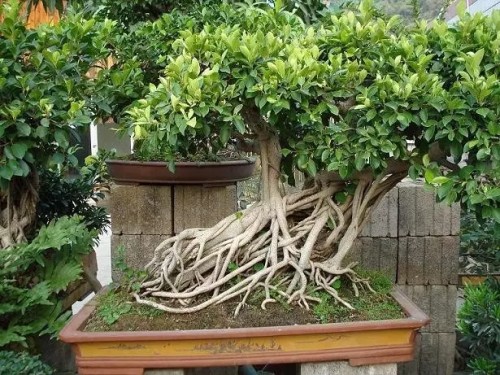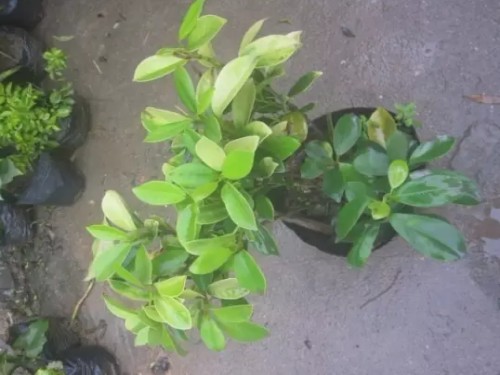How to turn pots and change soil for tree stump bonsai
After a period of growth of stump bonsai, the root system is full of pot soil, crisscross, so that the ability to absorb fertilizer and water is weakened, and the nutrient elements in the pot soil are becoming less and less, which is unfavorable for the growth of stumps. Therefore, it is necessary to turn over the pot and change the soil.
Turning pots is generally carried out in September or early spring to Qingming in autumn. Tree species with rapid root growth, such as pomegranate, triangular maple, etc., can be turned over once every 1-2 years; tree species with slow growth, such as conifers, can be turned over once every 3-4 years.
The raw material of pot soil, usually decayed leaf soil, can be made from mountain mud, garden soil and fallen leaves. The specific method is: after the trees fall leaves in late autumn, dig a pit I meter deep in an open and convenient place, pile up the fallen leaves and mountain mud or garden soil layer by layer, and pour some human excrement. The pile is 20 cm high and is sealed with mud all around to ferment it. After about 1 month, the pile is turned I times. After 3 months, the leaves rot and can be sieved for pot soil.
Turning pots generally only changes the pot soil without changing the pot. The pile scene from the basin out, remove the soil around the ball, easy to root trees such as Vitex, elm, etc., the soil can be removed about 50%; difficult to root conifers, only remove 20%-30% of the soil. If the root system is underdeveloped, the new root is poorly developed, the fibrous root is not covered with the bottom of the soil block, less or no soil should be removed, and part of the old root and rotten root should be cut off, and the cut should be smooth.
After turning over the pot, use the "deep pot shallow planting method"(if the shallow pot, use this method to shorten the recovery period). That is, add a layer of 4 - 6 cm high hard plastic ring at the mouth of the basin. In this way, more broken tiles and coarse culture soil can be added to the bottom of the basin to raise the bottom of the basin and promote the positioning of the roots. Then fill the new culture soil to 1-2 cm away from the plastic ring mouth with the conventional method, wait for new roots to grow, and then remove the plastic ring after recovering growth. Later, through watering and rain washing, the soil higher than the pot surface gradually falls off to achieve the purpose of natural root extraction.
After turning over the pot, you can water it. Because the soil of new turn over a basin is more loose, usable spray pot sprays water, but water must irrigate sufficient for the first time, irrigate thoroughly (family raises a flower to be usable "seat basin law" water), place half shade place, do not irrigate later. Because at this time pot tree water absorption is weak, watering too much, easy to cause rotten roots. Evergreen trees spray water on their leaves to increase air relative humidity and reduce foliar evaporation. When the potted tree sprouts new roots and the growth potential recovers (about 20 days), it can be transferred to normal watering.
Stump bonsai pot, soil capacity is small, after 2-3 years on the pot, the nutrients in the soil will be exhausted, the soil will be stiff, unfavorable to plant growth, so it must be turned over for soil.
1. Time to turn over the basin
Whether it is turning pots for soil or changing into large pots, it is best to carry out in the dormant period of deciduous trees or the slow growth period of evergreen trees. If it is carried out in the vigorous growth season, wilting or falling leaves will certainly occur.
In some special cases, such as underground pests appear in the pot soil, or because of the need for commodity sales and flower display, it is necessary to turn over the pot to change the soil or change the pot during the growing season, then it is necessary to do a good job of shading and moisturizing, spray more water to the leaves and keep the pot soil in good ventilation conditions.
2. Method of turning over pots and changing soil
After the stumps are removed from the pots, first remove about half of the surrounding old soil with bamboo chips, and then trim the roots properly. For some disc-shaped shallow pots, no tiles are used to line the drainage bottom holes before the soil, especially some micro-bonsai, their height is not much higher than the tiles. At this time, plastic window screens should be used to block the drainage holes to prevent the pot soil from being exposed.
3. Interval of basin turning
The age of pot turning should be controlled flexibly according to the growth habit of tree species and the size of original pot. Pomegranates, wolfberry and other flowers and fruits pile scene consumption of nutrients, it is best to turn the pot once a year to change the soil, but do not change into a large pot, otherwise the plant expands year by year and cannot be controlled, so that it grows into a big tree and loses the significance of pile scene.
June snow and other broadleaf trees can be replaced once every two years. Conifers grow slowly and can be replaced once every three years. Large pile landscape soil replacement every 3-5 years, medium soil replacement every 2-3 years. The older the stump, the longer the interval between soil replacement. Stump bonsai is the older the more expensive, but can not grow into a big tree, trunk can be allowed to grow thick, and crown should be controlled in the appropriate size and height, in addition to pruning to achieve the above purposes, control fertilizer and reduce nutrient area is also very important, so do not rush into the big pot.
Pots for tree stump bonsai are generally small and shallow, with little soil capacity, and nutrients in the culture soil will be consumed in a short time. Root system also can be full of whole basin and will basin soil top basin surface, so that can not water, located in the bottom of the basin and basin side of the lateral roots and fibrous roots are often withered death, resulting in thin leaves yellow and lifeless. Therefore, according to the situation, the pot should be changed in time, and at the same time, the root system should be pruned.
Turning pots and changing soil should be carried out before budding in spring, and it is best to pick them all before Qingming in mass production. If the pot is turned over and replaced in the growing season, the branches and shoots are often withered due to pruning of roots. Unless underground pests occur in the pot soil or in order to sell and participate in bonsai exhibitions, it is necessary to remove the old soil or replace it into exquisite bonsai pots. When it is necessary to change pots in the growing season, shade and moisture should be done well. Spray more water on the leaves and less water in the pots. Otherwise, not only will wilting occur, but also rotten roots.
After the stump is removed from the original pot, remove the root soil by 1/2-2/3 with bamboo chips, and then trim the root system. Conifer species tend to have more downward-growing taproots than lateral roots, and fewer fibrous roots. These taproots grow once a year at the bottom of the pot and several times a year without turning over the pot. However, their ability to absorb water nutrients is not strong, but also easy to push the pot soil out of the pot surface, so these taproots should be re-cut, on the one hand, to free up area to add new culture soil, re-cut can also promote the germination of lateral roots and fibrous roots to increase absorption capacity.
As far as possible, do not replace the formed stump bonsai into a large pot in order to control their growth and maintain the original tree shape. If the basin is too large, the nutrient area is too large, once the excess length, the tree is difficult to control, but also appears top-heavy so that the proportion is out of balance. When using dish shape or boat shape shallow basin, the drainage bottom hole inside basin should not use tile lining again, but plastic window screen can be used instead to prevent basin soil leakage. When planting stumps, if round or tubular flowerpots are used, the trunk should be planted in the center of the flowerpot. If rectangular or oval flowerpots are used, the trunk should be tilted to one side, and the empty pot surface can be placed with stones and ornaments.
Time: 2019-06-01 Click:
- Prev

How to preserve the bonsai of small leaf banyan
Small-leaf banyan is a common plant in the south, which has thick aerial roots like all banyan plants. These gas roots are very elegant, like hanging curtains, but they are firmly directed at the land, and the feel is not soft and smooth but full of strength. Once buried, they can grow roots and support the continuous extension of the tree crown.
- Next

What if the leaves of small-leaf banyan bonsai turn yellow?
Small-leaf banyan bonsai also belongs to a kind of banyan bonsai, belonging to Moraceae and the fruit is spherical, and the color of the fruit is diverse, mostly red. Small-leaf banyan is based on banyan tree as the basic material. in order to achieve the purpose of pruning the stump, rhizome and leaves of the ornamental banyan tree. But in our daily maintenance process,
Related
- Fuxing push coffee new agricultural production and marketing class: lack of small-scale processing plants
- Jujube rice field leisure farm deep ploughing Yilan for five years to create a space for organic food and play
- Nongyu Farm-A trial of organic papaya for brave women with advanced technology
- Four points for attention in the prevention and control of diseases and insect pests of edible fungi
- How to add nutrient solution to Edible Fungi
- Is there any good way to control edible fungus mites?
- Open Inoculation Technology of Edible Fungi
- Is there any clever way to use fertilizer for edible fungus in winter?
- What agents are used to kill the pathogens of edible fungi in the mushroom shed?
- Rapid drying of Edible Fungi

